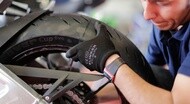
Motorcycle Tips and Advice
Your safety comes first: Check your tires
Worn tires can ruin your vehicle's performance and even endanger you or your loved ones. It is recommended that you do a weekly inspection to check:
- The state of the tires
- The depth of the treads
- Any damage due to impacts or any sign of unusual wear.
You are also advised to check your tire pressure twice a month.
If in doubt, always ask for expert advice!
Six reasons to change your tires
1. The tire has a puncture
Tires are durable and designed to withstand impacts, but they sometimes puncture. If you get a flat tire, it should be replaced by a professional mechanic.
2. The legal tread wear limit has been reached
A Michelin Man symbol on the upper side of your tires means that they feature a tread wear indicator. Similar to little bumps, these can be found at the bottom of the main grooves.
When the rubber has worn down to this level, the tire has reached its legal wear limit of 2/32nds. Michelin strongly advises you to change your tires before reaching this point. Past this point, there is no guarantee that your tires will keep you safe or deliver grip and performance, particularly on wet surfaces.
3. Tires show signs of aging
It is difficult to predict a tire's lifespan because it bears no relation to its manufacturing date. Tires that have never been used, or have only been used infrequently, may still show signs of aging. Many factors can affect their lifespan: weather conditions, storage and usage conditions, load, speed, tire pressure, maintenance, riding style, and so on.
Michelin recommends that all riders regularly spend some time inspecting their tires to pick up on any external signs of aging or wear, such as deformations or cracks in the tread, on the shoulders or sides.
You should also have your tires checked by a professional who can assess if they should be replaced or not.
The 5 year test… before it's too late!
After 5 years or more of use, tires should be examined every year by a professional mechanic. If the tires need to be changed, follow the manufacturer's recommendations with regard to replacing original components. As a precaution, all tires that have not been replaced after ten years should be changed, even if they appear to be in a generally good condition and have not reached their tread wear limit.
4. The tire is damaged
Pavements, holes or blunt objects can seriously damage tires. All tears, cuts or deformations should be carefully examined by a professional mechanic.
As a general rule, don't ride on damaged or flat tires. If the tire contains a puncture, it should be replaced.
When is a tire damaged beyond repair?
- Punctures to the sides of the tire
- Deformed or visible beads
- Tread rubber becoming unstuck or deformed
- Wear leading to a visible breaker or carcass under the treads or on the side
- Damage due to oils or corrosive substances
- Marbling or scratches to the inside faces as a result of riding with insufficient tire pressure.
5. The tire shows an unusual pattern of wear
Unusual wear of the tire treads – localized in certain places, in the center or on the shoulders – is often a sign of a mechanical problem (worn shock absorbers, transmission, fixings, etc.) or a balance issue. It can also occur as a result of incorrect tire pressure.
To prevent unusual wear, check your wheel balance every six months. This will prolong tire life and ensure a more comfortable ride. Aside from this, your tires may seem excessively worn for their mileage compared with other motorcycles ridden in the exact same conditions.
If this happens, contact your specialist.
6. You have the wrong tires for your vehicle
Choose your tires in accordance with legal requirements and the kind of equipment recommended for your vehicle. For optimal performance, use tires with the same tread pattern for the front and back. Tires that have different designs, treads and wear patterns might affect the vehicle's balance and stability. Never fit a vehicle with one radial tire and one non-radial tire unless specified by the manufacturer.
When the time comes to change your tires, check out our tire selector or consult one of our specialists to be sure you make the right choice.

